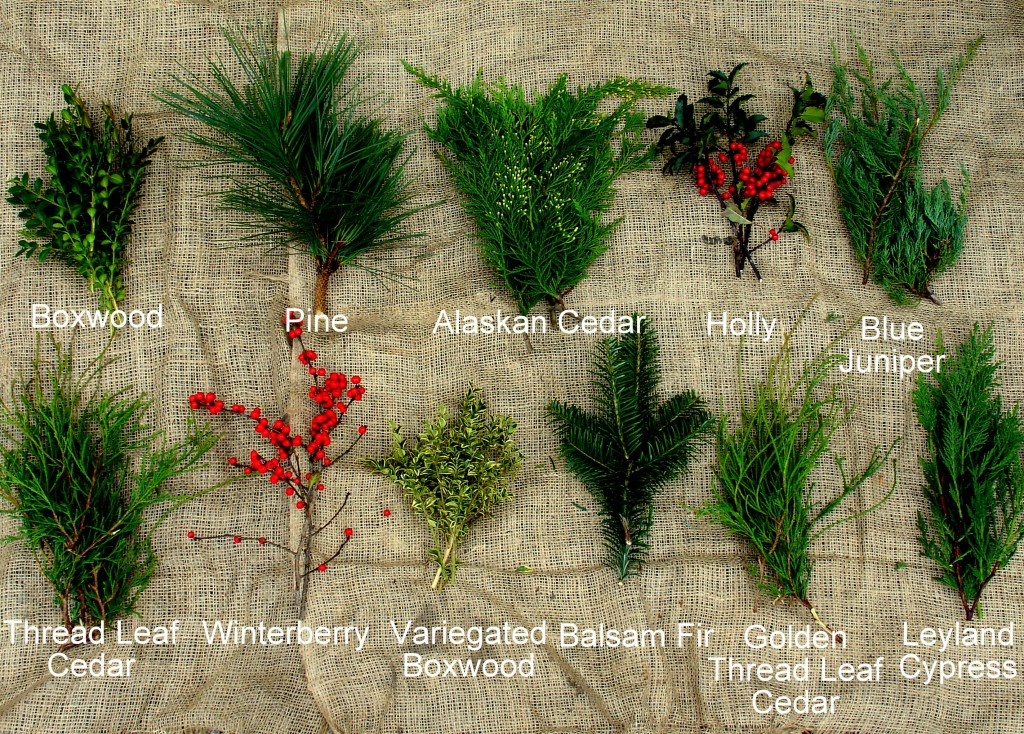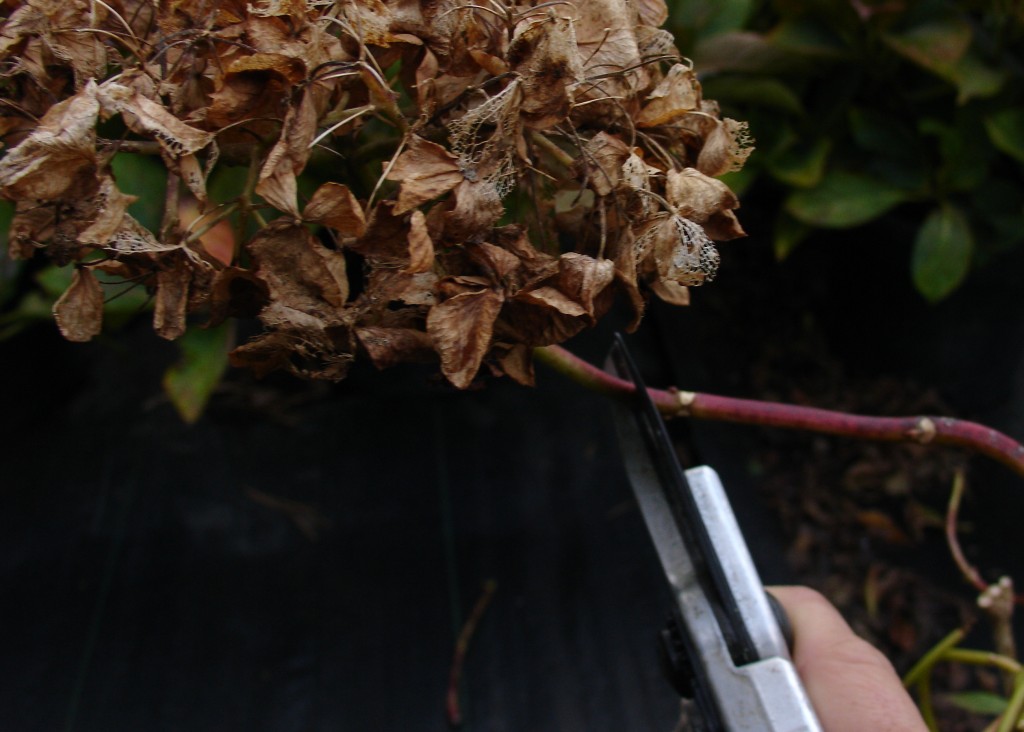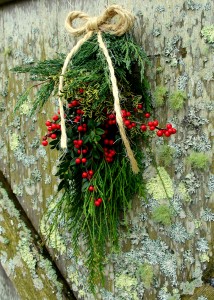 Not every door calls for a wreath. One of the fastest ways to create a decoration for a door is by bunching greens and berries together into swags. This example has Blue Juniper, Variegated Boxwood, Winter berry, Green Boxwood, Golden Thread leaf Cedar and Weeping Alaskan Cedar. We used zip ties to create small bunches of each variety, then zipped them together in contrasting rows. Once secure, we made a loop of wire for hanging and tied a bow with twine.
Not every door calls for a wreath. One of the fastest ways to create a decoration for a door is by bunching greens and berries together into swags. This example has Blue Juniper, Variegated Boxwood, Winter berry, Green Boxwood, Golden Thread leaf Cedar and Weeping Alaskan Cedar. We used zip ties to create small bunches of each variety, then zipped them together in contrasting rows. Once secure, we made a loop of wire for hanging and tied a bow with twine.
Woody Ornamentals
Plant Your Seasonal Greenery
Professional landscapers and home owners alike, often buy branches of greenery and berries to decorate Island homes for the holidays. The variety of items available commercially is varied, but can become expensive if you have a lot of decorating to do.
If you have some room, why not consider growing your own? We offer a huge variety of evergreen trees and shrubs at the Nursery for sale. Leyland Cypress, Cedar, Pine, Juniper, Fir and Spruce trees make a great addition to Nantucket landscapes. Fortunately, all of these trees can use a little pruning from time to time to keep a neat, dense habit. Why not do your pruning now and enjoy the branches? Evergreens are well on their way to full dormancy, so have no fear, borrow as many branches as you need, while maintaining a balanced tree.
While you’re at it, consider adding some plants with red berries, as well. Holly is the perfect combination of lustrous green foliage and deep-red berries. Another great plant for berries is Winter berry. Plant winter berry in front of larger evergreen trees in the garden. The green backdrop shows off the red berries in plantings just as when it is cut and made into garlands, wreaths and swags.
Dead Heading Hydrangeas
The once brilliant blooms on your Hydrangeas are now brown and crispy. They look especially horrible as they float above the plant on leafless stems. Is it ok to cut them off? Sure!
Flower heads that are not removed this time of year, are very likely to break off anyway and blow around the yard during winter. They will collect in the strangest places; in window wells, at the base of stone walls and most egregiously — inside your Spiraeas! Spent Hydrangea blossoms are easily pruned away. Just cut above a healthy set of buds below the flower.
If you would rather not do yard work this time of year, don’t worry, there is no harm in leaving them on the plant. Actually, some gardeners feel strongly that they protect the buds at the tips of the branches. I’ve never found that to be the case on Nantucket, so I happily dead-head away.
Heptacodium miconoides
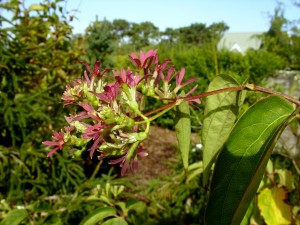
One of the most interesting plants in our display garden by Somerset Road is Seven Son Flower, Heptacodium micronoides. Introduced in 1980 from China, this small tree hasn’t been in cultivation for long, but is deserving of more attention. Michael Dirr, the Woody plant guru, extols its virtues in his Manual of Woody Landscape Plants. And I say, what’s good enough for Dirr is good enough for me!
This plant takes on the habit of a small upright tree, reaching 20 or more feet in height. You wouldn’t be totally amiss to confuse it with a Crape Myrtle. But in my mind it makes a nicer specimen. The dark green ovate foliage looks beautiful during the growing season. Then, in August the entire tree is covered in panicles of small, fragrant white flowers. As the flowers fade, the pink sepals at the base of the flowers become the star. They persist for two or three weeks, often into October. When the frost causes the leaves to fall, there is still more to see. The branching structure is irregular and beautiful, especially highlighted by exfoliating bark. The white outer bark peels away contrasting beautifully with a darker bark beneath.
Planted in moist, but well drained, slightly acid soil, this plant will reward you for years to come. If you would like to see a specimen as planted, we would be happy to show you ours, thriving along Somerset Road.
What’s it Thuja?
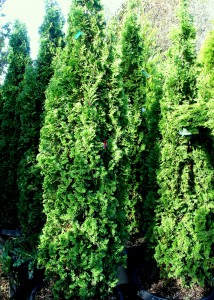
Before the popularity of Leyland Cypress, Arborvitae reined supreme! In the genus Thuja (Greek for Juniper), these are graceful evergreen needled trees. They make beautiful evergreen hedges, and upright specimens.
Thuja occidentalis tends to be a tighter species with little to no taper as they increase in height.
- ‘Elegantissima’ is an older cultivar whose needles are tipped in yellow. They are broadly pyramidal and will grow to 15′ tall and 5′ wide.
- ‘Smaragd’ aka ‘Emerald Green’ is touted to be an improvement since it holds its green color better in winter, and is more columnar. This cultivar is also somewhat smaller and slower growing than ‘Elegantissima’ topping out at 12′ tall and 3′ wide.
- ‘Nigra’, another common cultivar is also known to hold its deep green color in winter. It is very columnar and comes in at 20′ tall and only 3′ wide.
- ‘Degroots Spire’ is often used in applications where space is an issue, but an evergreen hedge is warranted. It grows very short branches, making it extremely columnar. Although it is said to grow 4′ wide and 15′ tall within twenty years, I expect it could be easily kept smaller with judicious pruning.
Thuja plicata and its cultivars and hybrids are known to be more deer resistant than T. Occidentalis.
- x ‘Green Giant’ aka ‘Spring Grove’ & ‘Grovpli’, is the most prominent cultivar in this species. The common name, Giant Arborvitae, speaks to the fact that these are naturally huge trees. They grow 3-5′ a year, once established, quickly reaching a height of more than 30′ and a width of more than 12′. Keep in mind, these trees are pyramidal, and can take up a lot of room in a small yard, unless maintained consistently with trimming.
Winterberry
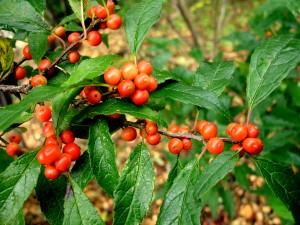
Now that we are firmly planted in Autumn, many deciduous plants have begun to shed their leaves. At this time of year, shrubs with showy berries really prove their worth in the landscape. One of the best for fall berries is Ilex verticillata.
Although there is a range of color in the various cultivars and hybrids, red is still the most prevalent in this species. The tips of the branches are covered in berries this time of the year. The berries cling to the twigs long after Christmas Stroll, even when cut and used to accent lying, wreaths, and planters. That’s why so many landscapers and home gardeners use it for seasonal decorating.
Winterberry loves low lying, moist, fertile areas. It will do well in part shade, but situated in full sun, it will produce the most berries. Keep in mind that these plants are dioecious, meaning male and female flowers are produced on separate plants. I order to ensure good pollination of the berry-producing females, it’s a good idea to plant at least one male for ever 20 females. That male can be located up to 50 feet away. If your new planting is on an area of the island with lots of native winterberry, you might not need to plant males, but it’s a good practice, just to hedge your bets.
The other consideration for heavy fruit-set is that most cultivars are best pollinated by different varieties. For example, the late flowering ‘Winter Red’ is best pollinated by ‘Southern Gentleman’, or ‘Apollo’ which also flowers later in the season. ‘Red Sprite’ on the other hand, is best pollinated by ‘Jim Dandy’.
NOTE: The Polly Hill Arboretum on Martha’s Vineyard has been doing work with winterberries for a number of years. We recently contacted them to see if they had any recommendations for good winterberries on the Cape and Islands. ‘Winter Red’ was their cultivar of choice.
Callicarpa dichotoma ‘Early Amethyst’
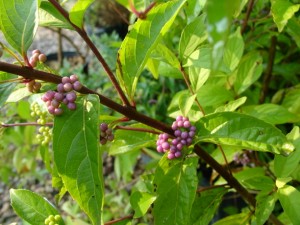 Using plants that have colorful fruit is a great way to interject long-lasting color into your landscape. Especially in fall, when we feel comfortable with the focus of the garden shifting away from flowers. The unusually purple fruit of Callicarpa will bring a welcome burst of energy to any landscape in late summer and well into the fall.
Using plants that have colorful fruit is a great way to interject long-lasting color into your landscape. Especially in fall, when we feel comfortable with the focus of the garden shifting away from flowers. The unusually purple fruit of Callicarpa will bring a welcome burst of energy to any landscape in late summer and well into the fall.
These graceful shrubs can reach 5 feet tall in ideal conditions. Full sun is best, but they lend themselves very well to planting at the edge of a wooded area where they will do well in part sun. They prefer an evenly moist root zone, but don’t require overly fertile soil to perform. And they are easy care, too. Maintenance is limited to removing dead branches in spring. If they do become overgrown, or overly twiggy, they will respond well to a major rejuvenation, by cutting back to within a foot of the ground. With no pest problems or disease issues to speak of, Beautyberry is a great plant for Nantucket!
Roses for Cutting
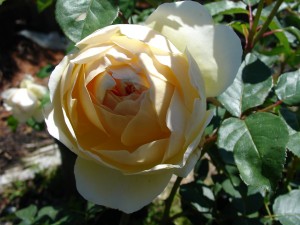 Technically, Modern roses are those roses bred after 1867. There are 14 categories for Modern roses, but Hybrid Teas, Grandifloras, and Floribundas are the best for cutting. They produce long stems with showy flowers that hold up well in a vase. David Austin’s English roses are a great choice as well.
Technically, Modern roses are those roses bred after 1867. There are 14 categories for Modern roses, but Hybrid Teas, Grandifloras, and Floribundas are the best for cutting. They produce long stems with showy flowers that hold up well in a vase. David Austin’s English roses are a great choice as well.
Unfortunately, it is true that Modern roses suitable for cutting require more work. Your reward for all that spraying, fertilizing and pruning is spectacular form, color and fragrance, that cannot be matched by Landscape Roses (or possibly, your florist!)
Take your time to meander through our rose section to see a wide variety of roses that will make your home and garden all the more beautiful.
Landscape Roses
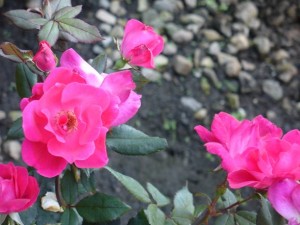
Although roses have a reputation of being difficult to grow, there are many roses that will perform even under less than ideal conditions with minimal care.
“Landscape Rose” is a general term for shrubs that bloom over a long period, are disease resistant, have attractive foliage, will perform in a range of soil types, and don’t require loads of specialized pruning to look great for the entire growing season. Roses like this can be used as focal points in a mixed border, or as mass plantings. They are also a good choice as the central player in large containers. Some of the most common are:
- ‘The Fairy’ – a light pink double-flowered shrub, introduced in 1932
- ‘Bonica’ – a medium-pink, double-flowered shrub, introduced in 1985
- ‘Knock Out’ Series – The original is cherry red, and now this popular series offers ‘Double Knock Out’, ‘Sunny Knock Out’, ‘White Out’, ‘Pink Knock Out’, ‘Pink Double Knock Out’, ‘Blushing Knock Out’ and ‘Rainbow Knock Out’
- ‘Home Run’ – a medium red single-flowered shrub introduced in 2006
We regularly carry these roses and our inventory is constantly changing. Please inquire as to what we have in stock. If you need a particular variety, stop by and make a request, we are always happy to order any rose that is available for our customers.
Vitex agnus-castus
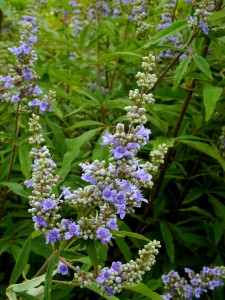 When we start getting questions about Lilacs in August, it’s sure that Vitex are blooming on the island. There are few flowering shrubs more beautiful than Vitex agnus-castus. Although this is one of the last shrubs to leaf out in the spring, it more than makes up for it in August. That’s when the entire canopy is covered in purple flowers, that are not dissimilar to French Lilacs.
When we start getting questions about Lilacs in August, it’s sure that Vitex are blooming on the island. There are few flowering shrubs more beautiful than Vitex agnus-castus. Although this is one of the last shrubs to leaf out in the spring, it more than makes up for it in August. That’s when the entire canopy is covered in purple flowers, that are not dissimilar to French Lilacs.
Vitex loves to bake in the full sun, with its roots in well drained soil. Although it must not be allowed to dry out immediately after planting, Vitex is considered drought tolerant. Its fragrant foliage is seldom bothered by deer or insects. It’s just a great shrub for the late summer garden!
Maintenance is limited to annual pruning in spring. Remove any dead or damaged branches. Tip flowered branches back to 2 sets of buds, to encourage strong growth during the upcoming season. Remove any wispy twigs smaller than a pencil, cutting right back to their point of origin. Finally take a step back, and make any last cuts to form a rounded shape.
We carry Vitex in a variety of sizes. We likely have a plant in stock that will fit your needs.

